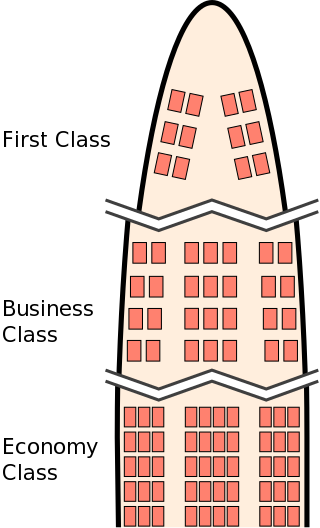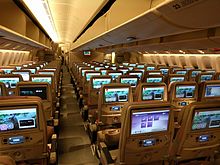Delta Air Lines is one of the major airlines of the United States and a legacy carrier headquartered in Atlanta, Georgia. The United States' oldest operating airline and the seventh-oldest operating worldwide, Delta along with its subsidiaries and regional affiliates, including Delta Connection, operates over 5,400 flights daily and serves 325 destinations in 52 countries on six continents. Delta is a founding member of the SkyTeam airline alliance. As of the end of 2022, it had 90,000 employees.

First class is the most luxurious and most expensive travel class of seats and service on a train, passenger ship, airplane, bus, or other system of transport. Compared to business class and economy class, it offers the best service and most comfortable accommodation.

Thomas Cook Airlines Limited was a British charter and scheduled airline headquartered in Manchester, England. It was founded in 2007 from the merger of Thomas Cook Group and MyTravel Group, and was part of the Thomas Cook Group Airlines. It served leisure destinations worldwide from its main bases at Manchester Airport and Gatwick Airport on a scheduled and charter basis. It also operated services from eight other bases around the United Kingdom. Thomas Cook Group and all UK entities including Thomas Cook Airlines entered compulsory liquidation on 23 September 2019.
EVA Airways Corporation is a Taiwanese international airline headquartered in Taoyuan City. It is one of the two largest airlines in Taiwan along with state-owned China Airlines. The privately-owned airline operates passenger and dedicated cargo services to over 40 international destinations in Asia, Australia, Europe & North America. Its network fully consists of international routes, with no domestic routes. It is rated as a 5-star airline by Skytrax, and is the second largest airline based in Taiwan after China Airlines. EVA Air is headquartered at Taoyuan International Airport in Luzhu, Taoyuan City. The company slogan is "Sharing the World, Flying Together".

A low-cost carrier (LCC) or low-cost airline, also called no-frills, budget or discount carrier or airline, is an airline that is operated with an emphasis on minimizing operating costs. It sacrifices certain traditional airline luxuries, for cheaper fares. To make up for revenue lost in decreased ticket prices, the airline may charge extra fees such as for carry-on baggage. As of April 2020, the world's largest low-cost carrier is Southwest Airlines, which operates primarily in the United States, as well as in some surrounding areas.

A travel class is a quality of accommodation on public transport. The accommodation could be a seat or a cabin for example. Higher travel classes are designed to be more comfortable and are typically more expensive.

Business class is a travel class available on many commercial airlines and rail lines, known by brand names which vary, by airline or rail company. In the airline industry, it was originally intended as an intermediate level of service between economy class and first class, but many airlines now offer business class as the highest level of service, having eliminated first class seating. Business class is distinguished from other travel classes by the quality of seating, food, drinks, ground service and other amenities. In commercial aviation, full business class is usually denoted 'J' or 'C' with schedule flexibility, but can be many other letters depending on circumstances.

Oasis Hong Kong Airlines Limited was a long-haul, low-cost Asian airline. It operated scheduled services to London Gatwick Airport and Vancouver International Airport from its hub, Hong Kong International Airport. The airline offered low fares as its selling technique, which was similar to the operation principle of a low-cost airline.

An airport lounge is a facility operated at many airports. Airport lounges offer, for selected passengers, comforts beyond those afforded in the airport terminal, such as more comfortable seating, quieter environments, and better access to customer service representatives. Other accommodations may include private meeting rooms, telephones, wireless internet access and other business services, along with provisions to enhance passenger comfort, such as free drinks, snacks, magazines, and showers.

An airline meal, airline food, or in-flight meal is a meal served to passengers on board a commercial airliner. These meals are prepared by specialist airline catering services and are normally served to passengers using an airline service trolley.
Brussels Airlines is the flag carrier and largest airline of Belgium, based and headquartered at Brussels Airport. It operates to over 100 destinations in Europe, North America and Africa and also offers charter services, maintenance and crew training. It is a member of the Star Alliance as well as the International Air Transport Association. The airline's IATA code SN is inherited from its predecessors, Sabena and SN Brussels Airlines. Brussels Airlines is part of the Lufthansa Group. The company slogan is ′You’re in good company′.

An airline seat is a seat on an airliner in which passengers are accommodated for the duration of the journey. Such seats are usually arranged in rows running across the airplane's fuselage. A diagram of such seats in an aircraft is called an aircraft seat map.
Boarding is the entry of passengers onto a vehicle, usually in public transportation. Boarding starts with entering the vehicle and ends with the seating of each passenger and closing the doors. The term is used in road, rail, water and air transport.

An aircraft cabin is the section of an aircraft in which passengers travel. Most modern commercial aircraft are pressurized, as cruising altitudes are high enough such that the surrounding atmosphere is too thin for passengers and crew to breathe.

Airport check-in is the process whereby an airline approves airplane passengers to board an airplane for a flight. Airlines typically use service counters found at airports for this process, and the check-in is normally handled by an airline itself or a handling agent working on behalf of an airline. Passengers usually hand over any baggage that they do not wish or are not allowed to carry in the aircraft's cabin and receive a boarding pass before they can proceed to board their aircraft.

Premium economy class, also known by brand names which vary by company, is a travel class offered on many airlines. It is usually positioned between standard economy class and business class in terms of price, comfort, and available amenities. In 1991, EVA Air was the first to introduce Evergreen Class, becoming the first airline to offer this class of service. It was widely acknowledged that the premium economy class has become a standard reflection of what the Business Class was like several decades ago. In some countries, this class has emerged as a response from governments and companies requiring economy class for travel done by staff, while still getting some benefits like airport priority.

In commercial aviation, buy on board (BoB) is a system in which in-flight food or beverages are not included in the ticket price but are purchased on board or ordered in advance as an optional extra during or after the booking process. Some airlines, including almost all low-cost carriers and a handful of flag-carriers, have buy-on-board food and beverages as part of their ancillary revenue generation.
An exit row is a row of seats on board a commercial airliner that is next to an emergency exit. Exit rows may be next to overwing exits or full-sized exit doors.
First class is a travel class on some passenger airliners intended to be more luxurious than business class, premium economy, and economy class. Originally all planes offered only one class of service, with a second class appearing first in 1955 when TWA introduced two different types of service on its Super Constellations.

Basic economy class is a travel class offered by a number of airlines. The class has superseded economy class as the cheapest airfare option for passengers and generally comes with more restrictions when compared to standard economy fares. Restrictions vary between different airlines, but they generally include not allowing passengers to change or cancel tickets or select seats for free. They are seen as a strategy for market segmentation.























